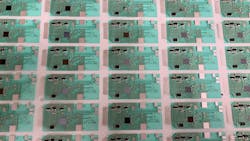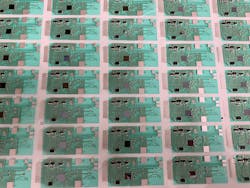The Path to Commercializing Flexible Hybrid Electronics
What you’ll learn:
- The starting point for roadmaps that lead to flexible hybrid electronics (FHE) commercialization.
- How to get developers through the “valley of death” between concept and commercialization.
- An on-the-market FHE solution to show how commercialization is realized.
Flexible hybrid electronics (FHE) technology is on the cusp of commercialization with emerging applications in wearables, medical devices, defense, communication, and transportation (see figure). Successful R&D projects, a robust pipeline of information, and clever application in early proof-of-concept devices have brought us to this point. Several FHE manufacturing processes have been established, including printing and chip attach. In addition, increased automation of most process steps, programming, and testing is well underway.
At this juncture, we see a need for a visionary roadmap that shows how FHE technologies will further evolve and how far the technology can be developed. This type of roadmap creates priorities for new developments, directs attention to overcoming challenges, and provides guidance for longer-term R&D investments.
It’s always helpful when such roadmaps are supported by prototypes and pilot projects that demonstrate FHE capabilities and its unique advantages, such as novel integration, new form factors, lighter weight, and fewer manufacturing steps. To date, numerous pilot application projects have yielded powerful demonstrators in environments such as defense, wearables, health monitoring, and transportation. FHE is now moving into products for the commercial market and will benefit from support of early adopters.
FHE in the Military
In the defense industry, military technology continues to reduce the need to put soldiers directly into harm's way. Despite this, boots on the ground are still required, as not every mission can be conducted virtually, and military personnel must be on-site in high-danger situations. Soldiers’ health and safety remains a priority, and there’s a growing demand for flexible, wearable devices that can monitor biomarkers for stress and fatigue. Soldiers can’t wear bulky, heavy devices. Any new equipment needs to conform to existing gear, while being light and comfortable to wear.
This is something NextFlex has focused on directly with a demonstration device that monitors military personnel in volatile environments. We call it the “Superman” project for its S shape on a shirt. From soldiers in combat to mechanic technicians in confined spaces, this addition to the uniform detects several variables like stress, body temperature, and speed of movement, while enabling direct communication.
The prototype at its core is meant to enable full-scope visualization to soldier health and safety, with further developments for heightened situational awareness and enhanced communication features. By proving the concept can work and be manufactured, we’re showing applications for the technology and proving its maturity to bring in early adopters.
The “Valley of Death”
This is the next major step in NextFlex’s roadmap, but it’s trickier than it may first appear. Everyone says they want to be innovators, but it’s easier to be fast followers of an already proven concept.
We refer to the period from early proof of concept to early commercialization as “the valley of death,” and it requires a few key elements to get through it. One is successful proof of concepts, such as what has been established with pilot projects. The second is, simply put, urgent need. Early adopters typically have a problem that’s painful enough whereby they’re willing to try something new. Thus, many are now considering the benefits of flexible hybrid electronics technology—fast to market, all-digital manufacturing processes, lightweight, cost-effective, and thin—to transform their products. But they need guidance.
Having open and transparent discussions with customers to address their pain points, while demonstrating reliability and cost-effectiveness, is key. Listening to customers is essential to identifying the underlying problem so that the technology provider’s offering addresses a real need. Communication with users and customers to test, and re-test, the value proposition of a new technology is critical throughout the design and development process.
Many developers in the FHE community know that the secret to this is a string of incremental steps that build upon each other, increasing performance and complexity at each step while allowing people to demonstrate their new technologies and get their supply chain up to speed. Here, innovators and developers such as the NextFlex member community help bridge the gap between ideas and prototypes to scale production and eventually commercialization. It allows the small wins to build on each other, resulting in commercially available FHE-powered systems and devices.
Building a Roadmap
NextFlex is developing its visionary roadmap in two ways. First, we align much of our development work at the Technology Hub to the U.S. Department of Defense’s (DoD) “Modernization Priorities,” which are strategic improvements to help keep our soldiers safe and secure. Secondly, our 11 Technical Working Groups are each tasked with developing a Manufacturing Roadmap that reveals the challenges ahead in each of their respective areas of expertise. These challenges, if they can be solved collaboratively, become the topics for our funded Project Calls.
Now in its sixth year, the NextFlex Project Call is a series of projects championed by members, industrial companies, and academia in partnership with government, to address the most needed developments in the FHE ecosystem. Bringing together companies in pre-competitive partnerships, these projects build flexible components, prove technology concepts, and create prototypes of projects like the GE Global Research-led hydration-monitoring sweat patch or the Xerox PARC and UCSD-led saliva-monitoring mouthguard.
The earliest Project Calls focused on components and application concepts, and later-stage projects addressed scaling manufacturing. Think of it like levels of a pyramid: Each Project Call builds on the last, building up higher and higher to more and more cases of commercialization.
Commercialization Examples
Commercialization is no longer theoretical. It’s moving ahead, with some exciting examples. Through initial collaboration with the military, Aptima-Sentinel sought to address safety for soldiers and workers in hazardous environments. These included confined spaces, areas in the presence of dangerous fumes and chemicals, or areas where workers are at greater risk of injury or death because they’re working alone or remotely.
Working through the process of bringing its idea to commercialization alongside NextFlex, the Air Force, and Lockheed Martin, Aptima-Sentinel created a FHE wearable sensor called SafeGuard. It combines environmental, human, and locational data, along with AI analytics, real-time detection, and alerting through the software platform.
Several commercial pilots are already lined up for the rest of the year, and the SafeGuard is ready for commercial sale—using flexible electronics and software that provide immediate insights when a worker is in a hazardous environment. The SafeGuard platform is now leading to new ideas in industrial monitoring for safety and security of machinery.
Using our pyramid analogy, the highest stone has been placed, and commercialization is achieved. As more developers get their projects across the finish line, the process will only become more refined and streamlined, opening doors for even more applications of FHE. It will create a paradigm to drive the creation of new kinds of electronics applications in just about every field we can imagine.
About the Author
Janos Veres
Director and VP of Engineering, NextFlex
Janos Veres is a technologist at heart, and he is passionate about the future of manufacturing and the new ecosystems enabled by digital technologies. Janos has held R&D, manufacturing, and management positions in electronics, displays, specialty materials, and printing companies including PARC, PolyPhotonix, Kodak, Merck, Avecia, Zeneca and Gestetner. He has developed printed circuits, functional materials, OLEDs, displays, medical devices, as well as novel process technologies.
Janos brings experience of industrial partnerships and joint development projects in the US, Europe and Asia. He holds a Ph.D. in Solid State Electronics from Imperial College, London, and is the author of over 45 patents.

